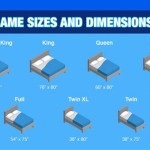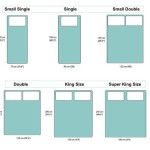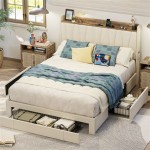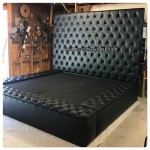Slats For King Size Beds: A Comprehensive Guide
King size beds, known for their generous sleeping space, require robust support systems to ensure both comfort and mattress longevity. Bed slats are a critical component of this support system. This article explores the different types of slats available for king size beds, the materials they are made from, factors to consider when choosing slats, proper installation techniques, and troubleshooting common issues.
Understanding the Importance of Bed Slats
Bed slats serve a fundamental purpose: to provide a stable and even surface for the mattress. Without adequate support, a mattress can sag, develop indentations, and lose its structural integrity prematurely. This not only affects the comfort of the bed but can also contribute to back pain and other physical discomforts. Slats distribute the weight of the sleeper and mattress evenly across the bed frame, preventing concentrated pressure points that lead to mattress degradation. The spacing and material of the slats directly impact their effectiveness in providing this support.
Insufficient slat support can also void mattress warranties. Many mattress manufacturers stipulate specific support requirements that include the type and spacing of slats. Failure to adhere to these requirements can result in the warranty being deemed invalid, leaving the owner responsible for any repairs or replacements needed due to inadequate support.
Beyond support, slats also contribute to mattress ventilation. The gaps between the slats allow air to circulate beneath the mattress, preventing moisture buildup. This is particularly important for mattresses made of materials like memory foam, which can trap heat and moisture. Proper ventilation helps to maintain a hygienic sleeping environment and extend the lifespan of the mattress by preventing mold and mildew growth.
Types of Bed Slats for King Size Beds
Several types of bed slats are commonly used in king size beds, each offering varying levels of support and durability. The choice of slat type depends on factors such as the sleeper's weight, the type of mattress being used, and the overall design of the bed frame.
Solid Wood Slats: These are often made from hardwoods like oak, maple, or poplar. Solid wood slats provide a firm and robust support base. They are typically wider and thicker than other types of slats, offering excellent weight distribution. Solid wood slats are generally considered to be the most durable option but can also be the most expensive.
The strength of solid wood slats lies in their inherent material properties. Hardwoods are naturally dense and resistant to bending or breaking under pressure. This makes them ideal for supporting heavier mattresses and sleepers. However, solid wood slats may not offer the same level of flexibility as other types, which can impact the overall comfort of the bed. They are best suited for those who prefer a firmer sleeping surface.
Engineered Wood Slats: Examples of engineered wood slats include those made from plywood or MDF (Medium-Density Fiberboard). These materials are created by bonding wood fibers together under pressure, resulting in a stable and consistent product. Engineered wood slats offer a cost-effective alternative to solid wood while still providing adequate support. They are typically more resistant to warping and cracking than solid wood slats.
Plywood slats are often preferred over MDF due to their greater strength and resistance to moisture. Plywood consists of multiple layers of wood veneer glued together with the grain running in alternating directions, which significantly increases its structural integrity. MDF, on the other hand, is more susceptible to damage from moisture and can be less durable over time.
Metal Slats: Metal slats are usually constructed from steel or aluminum. These slats are known for their strength and durability, making them suitable for supporting heavy mattresses and sleepers. Metal slats are often used in platform beds where aesthetics are less of a concern. They can be designed with different profiles, such as flat or curved, to provide varying levels of support and flexibility.
Steel slats are typically more robust than aluminum slats but can also be heavier. Aluminum slats are lighter and more resistant to corrosion. Metal slats can sometimes be perceived as less comfortable than wood slats due to their lack of flexibility. However, this can be mitigated by using a thick mattress or adding a mattress topper.
Sprung Slats: Sprung slats are designed to flex under pressure, providing additional support and comfort. These slats are typically made from layers of laminated wood or composite materials and are curved upwards. When weight is applied, the slats flatten out, absorbing some of the pressure and providing a more cushioning feel. Sprung slats are often used in conjunction with other types of slats to enhance the overall sleeping experience.
The curvature of sprung slats is a key factor in their performance. A more pronounced curve allows for greater flexibility and pressure absorption. The material used in the construction of sprung slats also affects their durability and responsiveness. Higher-quality sprung slats will maintain their shape and flexibility over time, while cheaper versions may lose their resilience.
Factors to Consider When Choosing Slats
Selecting the right slats for a king size bed involves considering several factors to ensure optimal support, comfort, and longevity. These factors include slat spacing, slat width and thickness, the type of mattress being used, the sleeper’s weight, and the bed frame design.
Slat Spacing: The distance between each slat is crucial for providing adequate support. Generally, the smaller the gap between slats, the better the support. Most mattress manufacturers recommend a slat spacing of no more than 2-3 inches. Wider gaps can lead to mattress sagging and premature wear, particularly for mattresses with thinner constructions or those made from materials like memory foam that tend to conform to the underlying surface.
If the bed frame has existing slats with wider spacing, it may be necessary to add additional slats to reduce the gaps. Alternatively, a bunkie board, which is a thin, flat platform placed on top of the slats, can be used to provide a solid and even surface for the mattress.
Slat Width and Thickness: The width and thickness of the slats determine their load-bearing capacity. Wider and thicker slats can support more weight without bending or breaking. A general guideline is to choose slats that are at least 3 inches wide and 0.75 inches thick. However, this can vary depending on the material and the overall design of the bed frame.
It is important to ensure that the slats are strong enough to support the combined weight of the mattress and the sleepers. Overloading the slats can lead to premature failure and compromise the support of the bed. For heavier individuals or those who prefer a firmer sleeping surface, it may be necessary to choose thicker and wider slats for added stability.
Mattress Type: The type of mattress being used can also influence the choice of slats. For example, memory foam mattresses often require very close slat spacing to prevent sagging, while innerspring mattresses may be more forgiving. Hybrid mattresses, which combine features of both memory foam and innerspring mattresses, typically require a moderate slat spacing.
Some mattress manufacturers provide specific recommendations regarding slat spacing and support requirements. It is always advisable to consult the mattress manufacturer's guidelines to ensure that the chosen slats are compatible with the mattress and will not void the warranty.
Sleeper’s Weight: The weight of the sleepers is a significant factor in determining the appropriate type and number of slats. Heavier individuals require more robust support to prevent sagging and ensure a comfortable sleeping surface. In general, more slats are needed to distribute the weight evenly and prevent excessive stress on individual slats.
Consider the combined weight of all sleepers who will be using the bed. Choose slats that are rated to support at least this weight. If necessary, add additional slats or reinforce the existing slats to provide extra support.
Bed Frame Design: The design of the bed frame can also affect the choice of slats. Some bed frames are designed to accommodate specific types of slats, while others are more flexible. It is important to ensure that the chosen slats are compatible with the bed frame and can be securely attached.
Consider the method of attachment used to secure the slats to the bed frame. Some bed frames have side rails with recessed areas for the slats to sit in, while others require the slats to be screwed or bolted in place. Choose slats that can be easily and securely attached to the bed frame to prevent shifting or movement.
Proper Installation of Bed Slats
Proper installation of bed slats is essential for ensuring optimal support and stability. Incorrect installation can lead to uneven weight distribution, premature wear, and even structural failure. The following steps outline the general process for installing bed slats in a king size bed.
Preparation: Before installing the slats, inspect the bed frame for any damage or defects. Ensure that the side rails are level and securely attached to the headboard and footboard. Gather all necessary tools and materials, including the slats, screws, a drill, a measuring tape, and a level. Remove the mattress and any bedding from the bed frame to provide a clear workspace.
Spacing and Placement: Measure the distance between the side rails of the bed frame. Cut the slats to the appropriate length, ensuring that they fit snugly between the rails. Use a measuring tape to determine the desired spacing between the slats. Mark the locations where the slats will be positioned on the side rails. Aim for equal spacing between all slats.
Attachment: Position each slat in its designated location. Depending on the design of the bed frame, the slats may be attached using screws, brackets, or other fasteners. If using screws, pre-drill pilot holes through the slats and into the side rails to prevent the wood from splitting. Use screws that are long enough to penetrate the side rails securely but not so long that they protrude through the other side. Ensure that each slat is securely attached and that there is no movement or play.
Reinforcement: For added support, particularly for heavier individuals or mattresses, consider reinforcing the slats with a center support beam. This beam runs along the center of the bed frame, perpendicular to the slats, and provides additional support to prevent sagging. The center support beam can be attached to the side rails using brackets or screws. Ensure that the beam is level and securely fastened.
Testing: Once all the slats are installed, test the bed frame by applying pressure to different areas. Check for any signs of instability or weakness. If necessary, add additional slats or reinforce the existing slats to improve the support. Use a level to ensure that the surface is even and that there are no dips or sags.
Troubleshooting Common Slat Issues
Even with proper installation, bed slats can occasionally experience problems that require troubleshooting. These issues can range from squeaking noises to broken slats, each requiring a specific solution.
Squeaking Noises: Squeaking noises are a common complaint associated with bed slats. These noises are typically caused by friction between the slats and the bed frame. To resolve this issue, try lubricating the contact points with a silicone-based lubricant. Alternatively, you can insert small pieces of felt or rubber between the slats and the frame to reduce friction.
Ensure that all screws and fasteners are tightened securely. Loose hardware can contribute to squeaking noises. Inspect the bed frame for any signs of damage or wear that could be causing the noise.
Broken Slats: Broken slats can compromise the support of the bed and lead to mattress sagging. Replace broken slats immediately to prevent further damage. When replacing a slat, use a replacement that is of the same size, material, and thickness as the original. Ensure that the replacement slat is securely attached to the bed frame.
If multiple slats are broken or showing signs of wear, it may be necessary to replace all the slats. Consider upgrading to stronger slats made from a more durable material.
Slat Movement: Slats that shift or move out of place can create uneven support and discomfort. To prevent slat movement, ensure that they are securely attached to the bed frame using screws or brackets. Consider using slat holders or clips to keep the slats in place.
If the bed frame does not have a system for securing the slats, you can add your own. Simple L-shaped brackets can be attached to the side rails to hold the slats in position.
Sagging: Sagging in the mattress can be a sign of inadequate slat support. This can be caused by insufficient slat spacing, weak slats, or uneven weight distribution. To address sagging, add additional slats to reduce the gaps between them. Consider replacing the existing slats with stronger, thicker slats. Ensure that the weight is evenly distributed across the bed by rotating the mattress regularly.
If the bed frame itself is sagging, it may be necessary to reinforce the frame with additional supports. Consult with a professional furniture repair specialist for assistance.

Glance 0 6875 In Standard Profile King Hfhsl 6 At Com

Bed Slats Split Frame King Size Closely Spaced 2 In Gap Wood Platform Replacement Boards Custom Width With Black Strapping Etsy

Vertical Bed Slats King Size With Closely Spaced Boards Use For A Mattress Without Box Spring Custom Width Thick Black Straps Etsy

King Size Replacement Bed Slats For Broken Boards Custom Width Mattress And Box Spring Support Eastern California Etsy

The Furniture King Bed Slats Size Wood Less Than 2 Inches Apart Specialty Platform Plank Frame Support Boards Attached With Black Strapping 79 Wide Wal Com

King Size Bed Slats For 5ft Frames

Bed Slats For King Replacement Support Wooden High End Easy Assembly 0 7 T X 2 1 W 76 L 13 Pieces Natural

Mattress Slats For King Size Bed 76x80 Inches In Addition To Order Teobeds Etsy

Frames And Rails King Wooden Roll Slats

Bed Slats Woodworker S Journal How To








